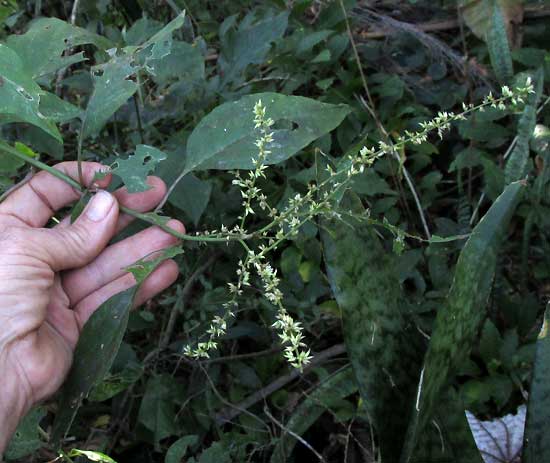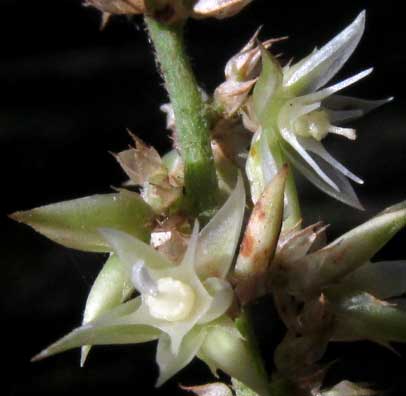Excerpts from Jim Conrad's
Naturalist Newsletter

from the February 7, 2016 Newsletter issued from Hacienda Chichen Resort beside Chichén Itzá Ruins; limestone bedrock; elevation ~39m (~128ft), N20.675°, W88.569°; central Yucatán state, MÉXICO
CHAMISSOA VINE
Near the hut a wall of secondary forest rises beside the trail, its young trees tangled with morning glories and other vines. One vine is different from the others, so stiff and tough it's almost a clambering shrub, and its flowers are tiny, held in large, open clusters that cascade from the wall. Above, you can see the whole thing silhouetted against the blue sky.
Up close, the vine-bush's leaves are soft and plain looking, with long, slender petioles, and the tiny flowers are pale and chaffy, in small clusters widely dispersed along the inflorescence's stem, or rachis, as shown below:

Even at that distance, those familiar with common weeds and wildflowers will recognize from the clusters of chaffy, pale flowers that this is a member of the Amaranth Family, the Amaranthaceae. Sometimes in this family the flowers are so tiny, closely packed and generally closed up that it's hard to find an open blossom, but on this plant with its widely spaced clusters open flowers are easy to find, and they're unusual and worth studying, as shown below:

Here are some notable features about the blossoms.
# There's no corolla, but five greenish-white sepals serve as petals.
# The five stamens unite at their bases to form a kind of white bowl in which the ovary sits.
# Atop the ovary at the style's base there's a white "circular ring." In our photo the ring shows best in the flower at upper right. I read that the mature one-seeded fruit is topped with a kind of "crown" apparently derived from the style's "ring." The fruit splits open "circumscissily," around its middle, where its top comes off. Maybe the fruit's crowns provide handles enabling birds more easily to pull off the fruit's tops to get at the seeds -- some which the bird then loses, disseminating the seeds the way the plant "wants" it to.
# Some flowers appear not to open like those in our picture. The literature says that certain blossoms are functionally only female, with undeveloped stamens
This vine is so distinctive that it was easy to identify just by doing image searches on the Amaranth Family species listed for the Yucatan. It's CHAMISSOA ALTISSIMA, commonly occurring in secondary forests from southern Mexico and the Caribbean south to Peru and Brazil. Sometimes the English name False Chaff Flower is applied to it, but that sounds like an editor's name that real people don't use, and I don't like names that label plants "False," so I prefer thinking of it as Chamissoa Vine, probably best pronounced KAM-eh-SO-ah.
Small, seed-eating birds must feed on Chamissoa Vine's seeds. The vine's preference for secondary forests makes it part of "Nature's First Aid Crew," helping forests reestablish themselves after being destroyed or damaged.